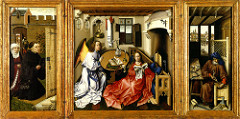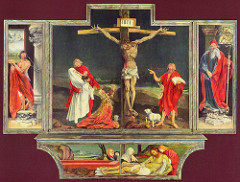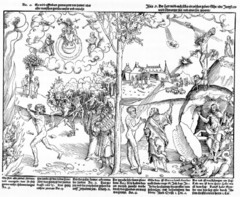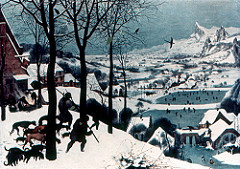
Date: 1427-1432
Period/style: Early Northern Renaissance
Artist: Workshop of Robert Campin
Patron: Name unknown, but depicted on the left side of the triptych
Location: Netherlands
Material/technique: Oil on wood
Function: Show the moment when Mary finds out that she is pregnant with Jesus
Context: Typical of Northern Renaissance religious art, this piece humanizes Mary and Joseph by showing them doing ordinary things. They are shown in a typical Flemish household, Joseph works as a carpenter, and Mary reads a prayerbook. The small details depicted are extremely typical of the Northern Renaissance because they focused on making the painting very symbolic. For example, the pail of water with towels in the background represents Mary’s purity, and the candle symbolizes the holy pregnancy. In the upper left hand corner, the Holy Spirit comes in through the window with a crucifix.
DT: symbolic, purity, humanized

Date: 1434
Period/style: Northern Renaissance
Artist: Jan van Eyck
Patron: Arnolfini
Location: Netherlands
Material/technique: Oil on wood painting
Function: Show the marriage of Arnolfini and his wife
Context: This painting acts as a marriage certificate, as seen by the signature in the back of Van Eyck, supporting him as a witness of the marriage. Arnolfini worked for the Medici family, and their family is represented by the oranges in the back. Common of the Renaissance in northern Europe, many small, representative details are shown. The dog at the feet of the couple represent loyalty and the lit candle stands for the consummation of the marriage. In addition, they two figures are both barefoot, showing that they are standing on holy ground. The convex mirror in the back represents the eye of God, therefore implying that he is present for the marriage and making it holy ground. Also, this piece is typical of the era because it humanizes the figures; this can be seen by the clogs in the foreground, which would be worn around the house, showing domesticity.
DT: detailed, marriage, Medici, symbolic

Date: 1541-1542
Period/style: Spanish Renaissance
Artist: Unknown and various
Patron: Antonia de Mendoza
Location: Viceroyalty of New Spain
Material/technique: Ink and color on paper, codex
Function: Codex meant to record information about Aztec empire
Context: The artists of this work were all indigenous people of the Aztec empire, but the codex is on European paper and it was commissioned by a Spaniard. The frontispiece shows symbols such as the eagle and cactus, which both represent a portion of the history of the empire’s founding. Corn appears around the edges of the piece, symbolizing the agricultural success of the empire.
DT: Aztec, codex, Spanish

Date: 1504
Period/style: Northern Renaissance
Artist: Albrecht Durer
Patron: unknown
Location: Germany
Material/technique: Engraving
Function: Show Adam and Eve before the fall of man
Context: The figures are shown in the contrapposto pose and with defined structure because this piece is highly influenced by classical sculpture of Greece and Rome. Common in the Northern Renaissance, every object depicted represents another thing. First off, the animals each symbolize one of the four humans. The cat is choleric, the rabbit sanguine, the elk melancholic, and the ox phlegmatic. By showing these four humors, the artist is trying to say that humans had a balance of the humors before the fall of Adam and Eve. More symbols include, obviously, the snake as Satan; however, the mouse can also represent Satan. Additionally, the tree behind Adam is known for repelling snakes, showing that he does not want to eat the apple that is offered by Eve.
DT: classical, symbolic, fall of man

Date: 1512-1516
Period/style: Northern Renaissance
Artist: Matthias Grunewald
Patron: Monks/nuns of monastery hospital
Location: German monastery hospital
Material/technique: Oil on wood painting
Function: Act as a altarpiece in the chapel of the hospital; show the relatable suffering of Jesus
Context: At this time, ergotism affected many people in Northern Europe, which was caused by a fungus that grew in grains. It caused boils and gangrene; thus, Jesus is shown as if suffering from ergotism. As a result, the patients in the hospital are able to relate to Jesus and they know that he understands their suffering. When the piece opens, Jesus’s arm even appears to be amputated, which was a common procedure for sufferers of ergotism. However, the interior of the altarpiece is golden and holy; this infers that the suffering of the patients will not continue in Heaven.
DT: ergot, disease, suffering

Date: c. 1530
Period/style: Northern Renaissance
Artist: Lucas Cranach the Elder
Patron: Unknown
Location: Germany
Material/technique: Woodcut and letterpress
Function: Show the Last Judgement on the left, and the blood of Christ on the right. This piece overall stresses the need for a personal relationship with God by acting as an allegory.
Context: This piece was created because of the rise of Protestantism; Luther stressed that salvation can only be achieved through alone, which is shown in this piece through the figure that is being sprayed by the blood of Jesus on the right. On the left, Catholicism is being looked down upon because Moses holds the Ten Commandments, which represents the beliefs of the Church, but a figure is still sent to Hell. Thus, the word of the Church is not enough to reach salvation.
DT: personal, faith, Protestantism, Luther

Date: 1565
Period/style: Northern Renaissance
Artist: Pieter Bruegel the Elder
Patron: unknown
Location: Northern Europe
Material/technique: Oil on wood painting
Function: Act as a part of the series, show the season of winter
Context: This piece was one of the first genre paintings, which shows ordinary people doing everyday things. This can be seen with the hunters walking back to the town and the people iceskating in the distance. This is typical of the Northern Renaissance period because of the high horizon line and the detailed atmospheric perspective; the eye of the viewer is drawn up towards the distant sky.
DT: ordinary, winter, atmospheric perspective, high horizon line




